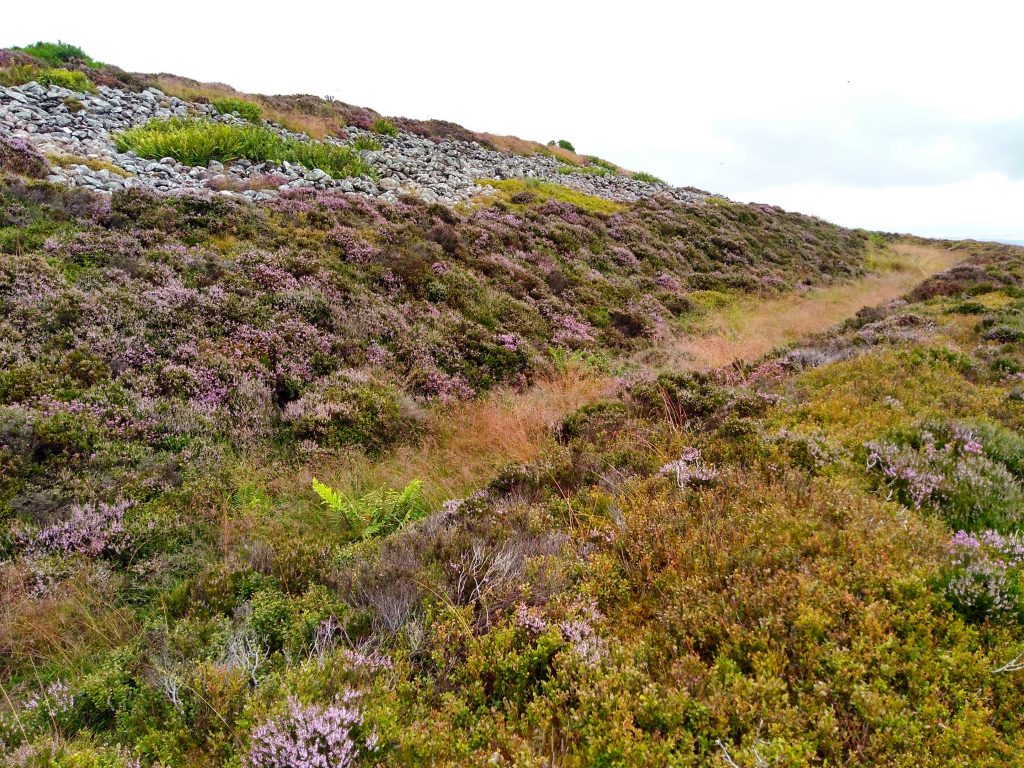The Site:
The Caterthuns are a pair of adjacent hillforts that date to the 1st and 2nd millennium BCE (scheduled monument SM90069). They are located in a rural part of Angus and are surrounded by farm land a shooting estate.
The site on privately owned land, under guardianship of Historic Environment Scotland, and is open year round with no charge. There has been no formal community engagement over the site and the total number of visitors is unknown. There is some conservation concern over cairn-building.
The Approach
This was a rapid, participatory study.
The total time spent on research activities, including preparation, was 7-8 days full time equivalent. This included 3 days spent at the site and in the surrounding area over a bank holiday weekend. A bank holiday weekend was chosen to maximise the potential for on-site contacts during daylight hours.
A short, six question structured interview was developed and trialled with in-person questioning and through self-completion. The in-person interviews were conducted at the site or in the nearby town of Edzell, approaching people in order as they arrived at the interview location. The other responses were gathered by the convener of a local community group, following a walk by the members at the site (with responses returned by post).
Semi-structured interviews were held with participants who were representatives of official bodies and/or lived close to the site (in one case by phone).
The interview methods were complemented by on-site observation (in total 15.5 hours), resulting in notes on how and when people arrived or passed by the site, who was visiting, and their activities or behaviour (as far as they could be observed from a particular vantage point).
Notes were also made of physical traces of unobserved activities, some of which were also mentioned in interviews, such as the remains of a fire in the well and a memorial wreath by the cup-marked stone.
Spending time at the site and walking between and around the forts on multiple occasions allowed for multi-sensory observations, recorded in notes and by taking photographs.
Transect walks were completed with three respondents with notes made afterwards of the discussions. Additional approaches were made to potential participants upon their arrival at the site, but several people were unwilling to undertake an accompanied walk, although some did complete a structured interview upon their return.
Off-site activities provided context to the limited time spent on-site. This consisted of a review of documentation shared by Historic Environment Scotland on the site, an online search of public participatory media (such as YouTube) and websites (such as WalkHighlands.co.uk), and posting information about the research to an online walker’s platform (one response received).
Discussion on the draft report took place over email and by telephone with respondents who preferred to give feedback verbally. Following completion of the study, discussions were held with Historic Environment Scotland as to how the social value statement could be incorporated into an updated Statement of Significance for the site.
The research identified several different communities for whom the site is of significance, including:
Local residents
Residents in the wider area
People originally from the area
Relations and friends (either visiting or commemorating)
Walkers
Dog owners
Runners*
Cyclists*
Berry pickers
Drone pilots
Photographers
Owners, workers and users of the estate
Campers
*As well as private/individuals, there have been running and cycling races that incorporate or pass between the hills.
People visit the site for a variety of reasons, individually and with family or friends. The research identified a number of different communities for whom the site is of significance and a variety of inter-connected values associated with the site. Key findings:
- The opportunity for solitude was explicit in how people valued the site.
- The experience, atmosphere and activities at the site are influenced by natural phenomena – changing seasons, time of day, and weather – and this was described in multi-sensory terms.
- The sense of place is connected to its history, location, memories and experiential aspects.
- For many people the hills are a place of peace and contemplation, which may be partly why the site is attracting memorial practices.
- Knowledge of the site is an expression of belonging and connection to place. Visiting was a regular practice for some people, but connections were also maintained from a distance.
- The site provides a connection to the wider landscape, of which it forms a part.
The report provides a stepping off point for further research or future actions. It concludes with some of the implications of the findings. Key points:
- Memorialising activity is likely to be more widespread and significant in how the site is valued than previously thought, involving a community of interest that is not necessarily based on location.
- Changes within the wider landscape – in particular those affecting the sightlines to or from the site and the ‘natural’ setting – may impact the values associated with the site.
It is recognised that the limitations of this study (time and access) mean that there are communities whose views are not represented. Further research would help to address recognised limitations in participation and scope, particularly with regard to:
- people involved in memorialising activities;
- owners, workers, and users of the estate and farm land on which the Caterthuns are located;
- younger people and those involved in family or communal events taking place in different seasons.

View to the White Caterthun from Brown Caterthun 
Collapsed stone walls and ditches, White Caterthun

Boundary marker surrounded by bilberry bushes, White Caterthun 
Cup-marked stone and memorial, White Caterthun